There are many legumes species commonly used for pasture or fodder in Kenya but only a few are important. Legume species are important supplements for livestock and at times ca completely replace purchased feeds if used properly.
This is a creeping and twinning perennial legume which climbs on anything nearby. It is mostly found in highlands and mixes well with most tall grasses. It smothers dwarf grasses.
The palatability is moderate but protein content is high. It can withstand heavy grazing and not easily shaded out.
It does best in medium to high altitude where the rainfall is more than 1000mm/year. It has a well developed root system therefore can survive in a wide range of soils. However the phosphate in the soil must be enough for nitrogen fixation.
The legume cannot withstand water logging. It is established by seeds at a rate of 1 – 2 Kg/ha which should be first inoculated with the right bacterial strain especially GB-1103.
This is a very robust trailing deep rooted legume. It has hairs on its surface and usually clings over grasses by means of fine hooks on the stems.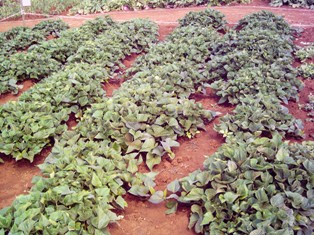
The legume is very nutritious with high protein content and very palatable. It is resistant to grazing but special management to regenerate is needed before animals are brought back after grazing. If this is not done the crop can easily disappear.
Establishment is through seeds at a rate of 1 – 3 Kg/ha and should be inoculated wth CB-627 strain of bacteria before sowing.
This legume is similar in characteristics to green leaf Desmodium except that the leaves has a silvery appearance.
Both do well in medium to high altitude areas with over 875 mm of rainfall per year. Inoculation is done the same way.
This is a trailing and twinning perennial legume. It has long stems that root easily which makes the crop resistant to drought. It has a large rooting capacity and the stems are hairy, unsymmetrical leaves which are very large. 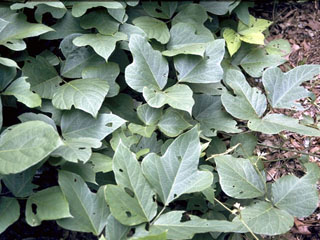
The legume does well in areas with as little as 750 mm/year of rainfall but is very demanding on soil requirements. The soil must be fertilized properly with the appropriate fertilizer especially the phosphorous and potassium. However, if grown in areas high in organic matter fertilizers may not be applied.
The legume cannot tolerate any water logging and is killed within 24 hours.
Establishment is by seeds and no inoculation is needed because bacteria form associations freely with the plant.
This is an erect and deeply rooted legume not suitable for grazing. If it is to be grazed a sound rotational pattern is required.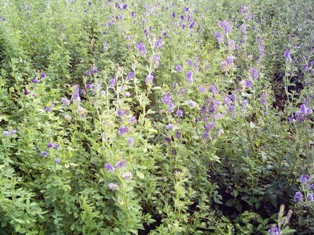
It is highly palatable and very nutritious with high protein content mostly used for hay making.
The legume requires deep fertile soils, well drained neutral to alkaline soil. The crop is sensitive to acidity and very sensitive to phosphorous, sulfur and boron deficiency therefore fertilizer application is necessary. The crop is not useful in very dry areas because it tends to shed its leaves prematurely. Irrigation is important in dry areas.
It is established by seeds at 3-4 Kg/ha. The seedbed should be well prepared and the seed should be inoculated but if the area had Lucerne growing previously then inoculation is not necessary.
This is a shrub that if uncontrolled can grow into a small tree. It produces high quantity of animal feed with high protein content.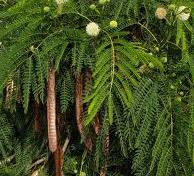
The legume can be browsed by cattle and other herbivores but browsing should be when the branches are less than 7 mm in diameter otherwise the fiber content will be high therefore proper management is required.
If not used for grazing then it can be harvested by cutting the branches when it is 90cm high. This can be repeated 3 – 4 times a year. The harvested material is coarser than the browse therefore should be used as supplement with other feeds. The yields are around 2700 – 4500 Kg/ha/yr with protein content approximately 20%.
They are deeply rooted therefore can withstand long dry periods. It grows in low to medium altitude areas but not in highlands. Establishment is by seeds and inoculated with CB81 bacterial strain. Before inoculation the seeds should be scarified to allow germination. Scarification may be by fire, sulphuric acid or hot water. Hot water at 80oC for 2 – 3 minutes then drying is usually preferred before inoculation.
This is a deep rooted perennial erect shrub but not as branched as leuciana. The stems are coarse and hairy while the leaves are small and sharply pointed.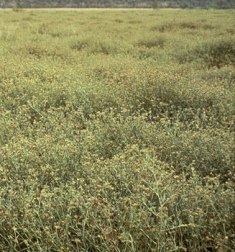
The legume is fairly productive but not very palatable to livestock and takes a while for animals to get used to it.
The palnt require warm climate therefore does best in low to medium altitude areas with annual rainfall above 875mm. It is sensitive to shading therefore growing with other crops needs much consideration. It is tolerant to low soil fertility however apply phosphorous fertilizer for improved production.
It is established through seeds which may or may not be inoculated.
A small perennial legume with smooth leaves and stems. It spreads freely by runners which root freely. Very palatable and nutritious, it mostly grows in association with Kikuyu grass.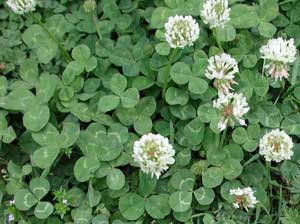
The legume cannot grow well in altitudes below 1700m and annual rainfall cannot be less than 875mm. The soils should drain freely and be fairly fertile.
It is established by seeds but in Kenya they establish themselves freely. There is no need for inoculation. The legume is sensitive to shading therefore grows well with short grasses especially Kikuyu grass.
Sesbania is a rapidly growing perennial tree that establishes easily and grows in difficult conditions. The tree can grow up to 15 m tall. It is well adapted to hot, humid environments in areas receiving about 800 mm. They are tolerant to both saline and alkaline soil conditions.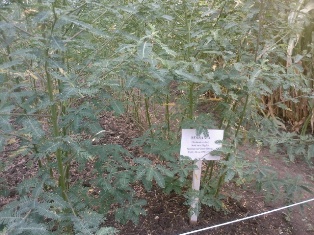
Usually established from seeds, S. sesban have a hard seed coat and scarification is recommended to ensure uniform seed germination but S. grandiflora is not hard-seeded and germinates well without scarification.
S. grandiflora cannot survive repeated cutting but the side branches can be cut for fodder. The trees are grown at 1.5-2 m intervals and forage can be harvested for 3-4 years, yielding up to 2 kg dry matter per harvest per tree. However S. sesban thrives under repeated cutting and coppices readily with many branches arising from the main stem below cutting height. Three to four cuts per year is recommended but up to eight cuts per year can be achieved.
Common Vetch is an annual climbing legume with semi prostrate stems and multiple green to dark green leaves. It is tolerant to light grazing and re-grow in pastures after moderate grazing. It forms dense, green foliage, 40-80 cm high. It has a very high animal feeding value that makes it excellent feed for growing and finishing livestock. It is readily consumed by livestock, either as green or dry feed, including mature seed pods. Dry residues of plants and pods provide a useful grazing crop.
Vetches are potentially adapted to most areas of the Kenyan highlands. They are adapted to a wide range of soils but prefer neutral to alkaline soils.
Vetches have a strong root system but are not well adapted to water logging. Planting should be no deeper than 3/4" into the soil and spacing at 17-19cm between rows. Triple Super phosphate fertilizers can be applied at 50-75kg/ha at sowing to provide a good start and growth but can be grown without fertilizer with good results.
The best time to harvest is at the flowering-early podding stage. At this stage the balance between feed value and yield is the best. The yields average 1.2t/ha under dry land conditions.
They can be grown in mixtures with with a range of short grasses like Kikuyu grass. For quality pastures use a mix of 2/3 vetch and 1/3 of grasses. Seeds are inoculated by Commercial Group E of bacterial strains.
When filling a silo additives may be added to increase the starch and sugar for microbes to act on and therefore produce the required acids. This is especially important if legumes compose a large part of the plant material to be ensiled.
Walls and floor should be covered with polythene sheet, then the top to control air flow. Later when continuing filling, the top polythene is removed, filling follows, and then covering again with polythene paper. This process is repeated until the silo is full. A layer of soil is applied on the top when filling is complete. Compression is done after each filling.
Young plants have high content. This reduces temperature therefore decreasing fermentation. Filling should therefore be done faster. Mature plants have more DM hence temperatures are raised and may cause excessive heating. Immature plants or water can be added to stop excessive heat.
To ensure satisfactory fermentation the crop should be chopped into small pieces. Large pieces make compaction difficult and air pockets leads to aerobic respiration, heat releases and overheating. The resulting silage is of poor quality.
Loading of silo should be progressive so that when the end is reached the material for ensiling is leveled off to give a uniform finish. The exposed slope should be covered with polythene sheet during breaks in filling and at night to ensure as little air as possible is in the ensiled mass.
Adequate compression is necessary to restrict loss of carbohydrates by respiration while leaving sufficient air in the mass to allow aerobic bacteria to convert carbohydrates to various organic acids. These organic compounds are lactic acids, acetic acids, propionic acid and butyric acids. Lactic acid is the most important. Presence of butyric acid indicates secondary fermentation therefore low quality silage.
Inadequate compression as with stemmy material leads to excessive respiration and overheating. This is accompanied by high losses of DM, reduction of digestibility of proteins and loss of carotene. Over compression on the other hand as is experienced when succulent herbage material is ensiled leads to overheating. The result is a foul smelling product unpalatable to livestock.
Good silage is made over temperature range between 10 and 38oC, the optimum being 32oC. Chopping of forage or crushing stemmy coarse plant material assists in compression. Materials with high moisture content should be wilted before ensiling. When ensiling young plant material with low level of carbohydrates, additives should be added. These additives ensure that lactic acid bacteria dominate other microbes in the silage making. Additives influence the type of fermentation hence the nutritive value of the resulting silage.
These stimulates production of lactic acid and are exemplified by molasses. sucrose, potatoes and cereals
They inhibit microbial growth partially or completely e.g. sodium hydroxide, carbon dioxide, sulphur dioxide, citric acid, acetic acid, formic acid and formaldehyde.
Is exemplified by propionic acid. Improves nutritive value of silage e.g. urea, ammonia, cereals, molasses, sucrose and potatoes.
The most common additive is molasses added 3 – 4% by weight and diluted with equal amount of water and applied as spray.
Making hay is one of the best ways to increase the year-round carrying capacity of the farm, as forage is harvested during periods of rapid, excess growth and then fed during stress periods. As a result, livestock farmers can feed cattle and other animals for 365 days in a year.
If hay is harvested at the proper stage of plant growth and undamaged by weather, it can provide nutrients at the lowest possible cost, except for pasture or silage. You can store grass as hay or silage depending on a number of considerations. In dry areas like most parts of Kenya especially Eastern and North Eastern provinces, it is easier to make hay than silage. Hay can be made from any amount of grass while silage needs a lot of grass; the heat in the dry areas easily spoils silage while hay requires heat to dry. To make good silage, air must be removed by pressing which is very hard for a farmer without machinery, while hay just needs a lot of air to dry quickly.
Haymaking serves two main purposes:
Hay can be made from planted or natural pastures. The first task is to choose when to start making hay. It is usually best at the end of rains when there is plenty of sunshine and plenty of forage. In Kenya this is usually around May/June after the long rains and October/November after the short rains when there is plenty of sunshine. When high quality hay is needed, the harvest must start at an early growth stage, such as late boot to very early head in grasses and late bud to early bloom in legumes. In mixed grass-legume stands, the decision for the first cut should be based on the grass since the grasses usually mature earlier than the legume.
For small scale operations the grass-legume can be cut with a sickle when half of the grasses have flowered. The grass-legume is then spread on the field to dry turning it once a day for 3 days.
a sickle when half of the grasses have flowered. The grass-legume is then spread on the field to dry turning it once a day for 3 days.
The dried grass-legume is finally baled using a simple box with dimensions of 3ft length, 1½ ft width and 2 ft depth and strings. The box is filled with dried grass-legume then tightly packed and tied with strings on both ends. The box is then lifted to release the bale. When tightly packed in the box the dried grass-legume should weigh about 15 kg. Baling is done by tying with a rope
A mower is used for large scale operations. Whether to use a disk mower or a sickle bar mower will depend on the size of the haying operation, the local economic situation, and the preferences of the owner. When reliable custom operators are available, it is often more practical for the small operation to use these services rather than owning the mowers and making the hay on their own.
The importance of tedding is to turn the swath and allow forage that was on the bottom or in clumps to come to the top and dry better, resulting in more uniform drying and reducing wet spots in the hay. If hay is tedded when it is too dry or if it is tedded too often, leaves will be broken off, causing a loss in forage quality and yield. The leaves are the part of the plant with the highest protein and digestibility. In most cases hay should be tedded once. Tedding should usually be done the morning after the hay is mown.
Raking the hay into a windrow allows for increased drying before the hay is baled. There are several new rake technologies that increase the openness of the windrow for drying. It is important to rake in a manner that will minimize leaf loss.
When hay is baled at higher moistures, leaf loss is reduced. However, the hay will not store properly and harmful bacteria may grow, causing health problems and possible livestock death. A baler is used for baling.
Drying agents are useful on legumes but not on grasses. They allow the water to dry from the legume forage faster, making it possible to bale the hay a few hours sooner. Preservatives allow the hay to be baled at higher moisture content without molding and spoiling. The practical and economic value of both of these technologies depends on local product availability and cost and on the economics of the hay’s planned use.
Losses in silage making can be in the field or in the silo. In the field losses are due to:-
In the silo losses are due to:-
Temperature during silage making is influenced by three factors
Good silage is made between 10 and 38oC the optimum being 32oC. If temperature is low then the ensiled material has high moisture content. To improve this decrease the amount of compaction and rate of filling. Moisture content can be reduced by wilting or adding materials less in moisture content like hay.
If temperatures are higher than 38oC usually experienced when ensiled material have high DM and low moisture content, the rate of ensiling and compaction should be increased. Materials with high moisture content or even water may be added to reduce the temperature of the ensiled material.
Page 4 of 8